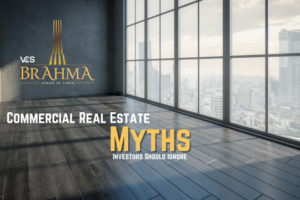The complexities of property taxes can be intimidating for a property owner or prospective buyer. VCS Promoters and Developers in Mohali is committed to creating environments and equipping their clients with the required information. This thorough tutorial will assist you in understanding property taxes on residential and commercial buildings.
What is Property Tax?
A tax charged on a property by the local government is known as a property tax. It’s critical to realize that different types of properties, such as residential and commercial, pay different property taxes.
Here are the calculations for each and all variables that are involved:
Commercial Property Tax
Commercial property tax is based on various factors including the property’s location, usage, and amenities.
Calculation Methods:
1. Unit Area Value System:
The method calculates property taxes based on specific property characteristics and location. It determines the unit area value by computing expected returns, influenced by the property’s usage and geographic location. This valuation is derived by multiplying the unit (per square foot per month), the area (location, street), and a predetermined rate (e.g., ₹1,500 per square meter). For example, a residential property covering 150 square meters would incur an annual property tax of ₹225,000, calculated at ₹1,500 per square meter. The formula for annual property value under this method is:
Annual Value=Covered Area×Unit Area Value×Age Factor×Use Factor×Structure Factor×Occupancy Factor
2. Capital Value-Based System:
The capital value-based system in India, notably used in cities like Mumbai, calculates property taxes based on the actual market value of properties, determined by the government using methods such as the stamp duty ready reckoner. This system features periodic updates every five years to reflect current property values accurately, ensuring tax rates remain relevant. It aims to be simple and transparent, facilitating compliance for property owners. Revenue neutrality is maintained, with tax collections not exceeding 40% of the previous year’s revenue, preventing excessive burdens.
Compared to older systems, it enhances tax collection efficiency by up to 200% . The system includes exemptions, such as no tax increase for residential houses with up to 500 square feet of carpet area, ensuring fairness in tax application. Overall, the Capital Value-Based System is structured to ensure equitable taxation aligned with property values, promoting fairness and efficiency in tax administration.
3. Annual Rental Value System:
The Annual Rental Value (ARV) System estimates the gross annual rent a property could generate if rented out, excluding furnishings and maintenance costs. It is determined by analyzing rents of similar properties nearby, considering size, location, condition, and other physical attributes.
ARV serves as the basis for property tax calculations rather than actual rental income. Common in former British Empire countries like the UK, India, Singapore, and some Australian states, it has two main variants: net annual rental value (tenant responsible for repairs) and gross rental value (landlord responsible). Specialized properties like refineries pose challenges. Property owners can dispute assessed ARV within a specified time.
Exemptions:
1. Religious Buildings: All buildings and lands used for religious purposes are exempted from the property tax.
2. Retired Soldiers: Retired soldiers and their widows/widowers are exempted from the property tax on the buildings and the lands they occupy.
Residential Property Tax
Residential property tax follows a similar framework but typically features lower tax rates compared to commercial properties. The assessment considers parameters like plinth area, zonal location, property age, and type of construction. Exemptions may apply for specific categories, such as small properties or properties used for religious purposes.
Comparing Commercial and Residential Property Tax
| Parameters | Commercial Property | Residential Property |
| Differences in Tax Rates | Higher due to greater value and revenue potential. | Lower |
| Assessment | Based on revenue potential, location, size, and type of commercial activity. | Based on utility as a living space, size, location, and amenities. |
| Standard Tax Deduction | 30% of gross rental income for repairs and maintenance. | 30% of the total rental income is allocated for maintenance and repairs. |
| Interest Deduction | Interest paid on loans for purchase, construction, or repair. | Interest paid (up to certain limits) on a home loan. |
| Taxation | Reflects anticipated higher income potential in Commercial zones. | Lower in Residential zones. |
How VCS Promoters and Developers Can Help
At VCS Promoters and Developers, we are committed to guiding you through every step of property ownership, including understanding your tax obligations. Whether you’re investing in a commercial space or buying your dream home, we ensure you have all the information needed to make informed decisions.
For more personalized advice or to explore our range of properties, get in touch with us, today. Let VCS Promoters and Developers be your trusted partner in your real estate journey.
Contact us At +91- 8699971020 to learn more about our properties and how we can assist you in making the right investment.





